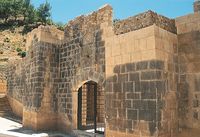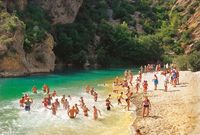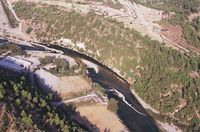Alarahan Caravanserai is the most famous and best preserved Anatolian caravanserai. It is a unique and exceptional architectural masterpiece. It stands beneath Alara Castle, across the road from the cool Alara River, and hosts traditional entertainment.
History, Construction and Legend
Although not large when compared to other caravanserais, the construction of this 13th century Seljuk building is very distinctive. It possesses one of the most complex plans of any caravanserai ever built. It is concentrically planned, consisting of two rings surrounding a central core. Historians assume that the inner ring was reserved for travellers and goods, whilst the outer ring was for services and animal stabling. It had its own mosque and baths.
Alarahan is a fine example of the stone masonry of the time. It was constructed from carefully joined, accurately hewn limestone blocks. The walls are as thick as 2 metres. During its construction, each quarryman carved his mark on the stones he had shaped (probably for payment purposes). The quarrymens’ marks helped to make Alarahan into the masterpiece that it is: no similar structures possess such a variety of carving.
Alarahan stands out not only because of its construction, plan and masonry, but also because of its intricate interior decoration. One of the most significant decorative elements inside Alarahan is the Mukarnas, a triangular interconnected geometrical shape that has a face of a lion in the middle. Triangles symbolized protection and security. The Mukarnas signs in Alarahan's interiors sought protection against the wicked and harmful.
Most caravanserais of the time were lit by small slit windows in their exterior walls, whereas Alarahan used 79 lion head sculptures to feed oil lamps. These Anatolian Lions symbolized Seljuk power, and are found frequently in Seljuk art.
Local legend says that the Anatolian Lions in Alarahan, which all have sad expressions, represented the homesickness felt by the travellers who stayed there. The same legend says that the lions smiled when the travellers safely reached their destinations.
Just 15 kilometres from the Mediterranean coastline, for centuries Alarahan served traders and merchants who carried their goods on the Alanya-Antalya and Alanya-Konya-Ankara roads. When the Silk Road lost its importance, Alarahan was turned into a dormitory for dervishes and it was abandoned by the 19th century.
Key Facts
- The refreshing winds that blow through the Alara valley make Alarahan, 38 km from Alanya on the west side, a tempting cooler alternative to the beach.
- The restored caravanserai is now a popular venue for Turkish folk shows, whilst fishing, mud baths, restaurants, etc. are found by the river.
- The hilltop ruins of a 13th century Seljuk castle, which was built to protect the travellers staying at Alarahan, overlook the caravanserai.
Shorex: Suitable for half days (especially evenings), and combines well with other attractions to the west of Alanya.





